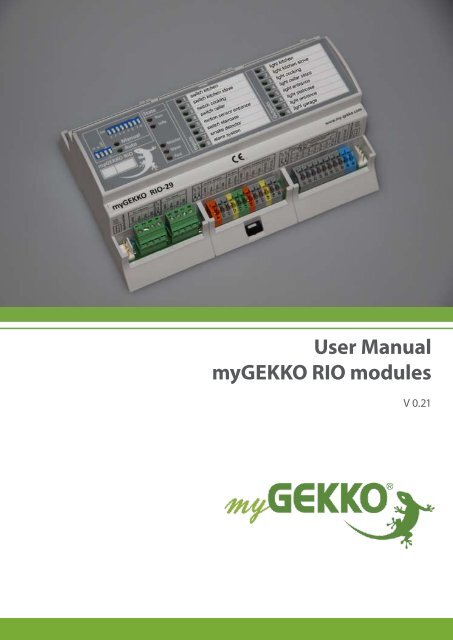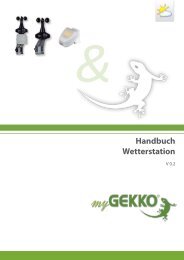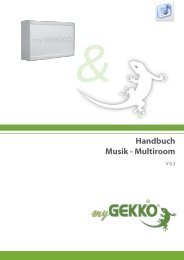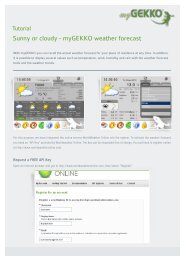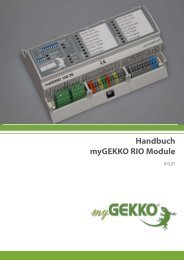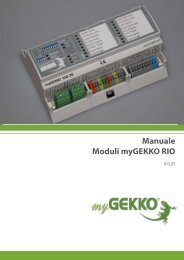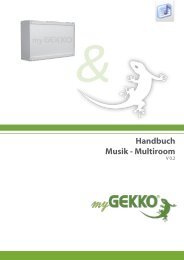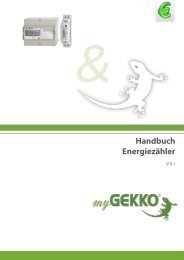User Manual myGEKKO RIO modules
User Manual myGEKKO RIO modules
User Manual myGEKKO RIO modules
- No tags were found...
You also want an ePaper? Increase the reach of your titles
YUMPU automatically turns print PDFs into web optimized ePapers that Google loves.
<strong>User</strong> <strong>Manual</strong><br />
<strong>myGEKKO</strong> <strong>RIO</strong> <strong>modules</strong><br />
V 0.21
®<br />
Latest Update: July 2012<br />
All software-related descriptions refer to the V1279 software. An update is recommended for older versions of the system. Small<br />
deviations of the descriptions are possible and due to changes in the software.<br />
All brands and logos are registered trademarks and are the property of the respective holders of the rights<br />
Copyright<br />
All rights reserved. No parts of this document may be reproduced or transmitted in any form by any means, electronic or<br />
mechanical, without the prior written authorization of its legal owner.<br />
If this publication is made available on Ekon GmbH media, Ekon gives its consent to downloading and printing copies of<br />
the content provided in this file only for private use and not for redistribution. No part of this publication may be modified,<br />
altered or used for commercial purposes. Ekon GmbH is not liable for the damages which arise from the use of an illegal<br />
modified or altered publication.<br />
All products correspond to the directly applicable EU regulations and guidelines.<br />
2
Table of Contents<br />
1. Introduction<br />
1.1 General Information ........................................................................ 4<br />
1.2 Sub-Bus configuration ...................................................................... 4<br />
2. Technical specifications<br />
2.1 Rio 29<br />
2.1.1 General technical specifications ........................................................... 6<br />
2.1.2 Digital inputs X4 .......................................................................... 7<br />
2.1.3 Analog inputs X5, X6 ...................................................................... 8<br />
2.1.4 Digital outputs X7 ........................................................................ 8<br />
2.1.5 Analog outputs X5, X6 .................................................................... 9<br />
2.1.6 Aux1 / RS-485 X3 ......................................................................... 9<br />
2.1.7 MBus X3 .................................................................................. 9<br />
2.1.8 Aux2 / RS-485 or RS-232 X3 ............................................................... 9<br />
2.1.9 Screw terminals .......................................................................... 10<br />
2.1.10 Spring clamp terminals ................................................................. 10<br />
2.1.11 Installation specifications <strong>RIO</strong> 29 ........................................................ 11<br />
2.1.12 Functional description Dip switch <strong>RIO</strong> 29 ................................................12<br />
2.2. Aux-8<br />
2.2.1 General technical specifications ......................................................... 14<br />
2.2.2 Digital PWM inputs X100 ................................................................ 15<br />
2.2.3 Analog outputs X101 ....................................................................15<br />
2.2.4 Connection example .....................................................................16<br />
2.2.5 Installation specifications ................................................................. 16<br />
2.2.6 Spring clamp terminals ...................................................................17<br />
2.3. Rio 16<br />
2.3.1 General technical specifications ......................................................... 18<br />
2.3.2 Digital inputs X4 ......................................................................... 19<br />
2.3.3 Digital outputs X5, X6, X7 ................................................................20<br />
2.3.4 Screw terminals .......................................................................... 20<br />
2.3.5 Spring clamp terminals ................................................................... 21<br />
2.3.6 Installation specifications <strong>RIO</strong> 16 ......................................................... 22<br />
2.3.7 Functional description Dip switch <strong>RIO</strong> 16 ................................................. 23<br />
2.4 Functional description LEDs .............................................26<br />
2.5 Buswiring ............................................................... 27<br />
2.6 Configurations example ................................................. 28<br />
2.7 Schematic example ..................................................... 30<br />
3. Installation manual ........................................................ 32<br />
4. Software activation at <strong>myGEKKO</strong> ........................................... 33<br />
3<br />
3
1. Introduction<br />
!<br />
WARNING: Read all safety information and instructions before using the <strong>RIO</strong> <strong>modules</strong> in order<br />
to avoid injuries.<br />
1.1 General Information<br />
The basic function of the <strong>RIO</strong>-<strong>modules</strong> consists of data acquisition (digital and analogue inputs) and the<br />
triggering of digital and analogue outputs respectively. <strong>RIO</strong>-<strong>modules</strong> are controlled via a RS-485 connection.<br />
The devices themselves have no intelligence.<br />
Solely, the operating status of the digital outputs can be determined in case of communication failure. The<br />
<strong>modules</strong> are built-in appliances and may be installed only by qualified personnel. The necessary covers must<br />
be in place (see section installation instruction).<br />
1.2 Sub-Bus configuration<br />
The maximum number of <strong>modules</strong> which can be connected to a <strong>RIO</strong>-29 bus coupler is 16 <strong>modules</strong> including<br />
bus coupler. Rio 16 or Rio 29 <strong>modules</strong> may be attached also in combination at will. The sub-bus <strong>modules</strong><br />
may also be mounted on several distributors distinctively.<br />
Example <strong>myGEKKO</strong> with one bus line divided among several distributors<br />
Rio-16 Rio-29 Rio-16 Rio-29 Rio-16<br />
RS485<br />
RS485<br />
Rio-29<br />
Rio-16<br />
A maximum of 4 bus lines can be operated on a <strong>myGEKKO</strong> Touch (4 bus couplers <strong>RIO</strong>29).<br />
Connections at the <strong>myGEKKO</strong> Touch<br />
Connections at the <strong>RIO</strong>29 bus coupler<br />
PIN SIGNAL<br />
2 RS485_GND<br />
3 RS485_TX (RxTx+)<br />
4 RS485_#TX (RxTx-)<br />
7 V+ (10-32V)<br />
8 V_GND<br />
recommended cable type<br />
Profibus L2FIP 1x2x0,65<br />
to the Sub-Bus<strong>modules</strong><br />
4
Example maximum configuration with 4 Bus-lines<br />
Rio-29<br />
...<br />
...<br />
Rio-29<br />
Rio-29<br />
...<br />
16 <strong>modules</strong><br />
RS485<br />
RS485<br />
Rio-29<br />
Rio-29 Rio-29 Rio-29 Rio-29 Rio-16<br />
Rio-16<br />
!<br />
Note that the supply of the <strong>modules</strong> must be fused with 3A. If the power consumption exceeds 3A the <strong>modules</strong><br />
have to be supplied separately.<br />
The bus must be wired accordingly to X1 or X2 (sub-bus). Therefore, the following connections are required:<br />
+24VDC do not connect, but supply separately<br />
RxTx+ connect to previous module<br />
RxTx- connect to previous module<br />
GND connect to previous module<br />
Bus coupler<br />
(1st module of the busline)<br />
Sub-Busmodule<br />
(more <strong>modules</strong>)<br />
max. 3 A<br />
max. 3 A<br />
3A<br />
3A<br />
+24VDC<br />
GND<br />
+24VDC<br />
GND<br />
5
2. Technical specifications<br />
2.1 <strong>RIO</strong> 29<br />
6
2.1.1 General technical specifications<br />
Parameters Value Notes<br />
Supply voltage 24VDC -25% / +30%<br />
Current consumption (internal) max. 250mA Typ. 100mA @ 24VDC<br />
Temperature range during - 20-50°C<br />
operation<br />
Storage temperature<br />
- 40-85°C<br />
Operating time 100% ED designed for continuous<br />
operation<br />
Degree of protection IP20 established via appropriate<br />
installation<br />
Contamination level 2<br />
Protection class<br />
II<br />
Principle of operation Type 1 EN60730-1<br />
Humidity max. 75% r.H. without condensation, during<br />
operation<br />
Software class<br />
Class A<br />
Dimensions 162mm x 110mm x 62mm L x W x H<br />
Weight<br />
280g<br />
EMV<br />
CE according to 2004/108/EG<br />
Rated surge voltage<br />
0,5kV<br />
Output PV at 24 VDC<br />
3 W<br />
2.1.2 Digital Inputs X4<br />
There is a galvanic isolation to the <strong>modules</strong> of all inputs via opto-couplers.<br />
Parameters<br />
Value<br />
Input type Optically separated /<br />
opto-couplers<br />
Isolation voltage<br />
400V<br />
Switch point On<br />
>9VDC<br />
Switch point Off<br />
2.1.3 Analog inputs X5, X6<br />
Parameters<br />
Value<br />
UI-x input range<br />
0-10V voltage input<br />
1mV (16 Bit ADC)<br />
0 – 10’000<br />
II-x input range<br />
0-20mA current input<br />
10uA (12 Bit ADC)<br />
0 – 2’000 uA<br />
TI-x input range<br />
PT1000<br />
0,1 Grad<br />
-500 – 2’500<br />
TI-x temperature range -50 – 250°C<br />
0-20 mA<br />
0-10 VDC<br />
PT 1.000<br />
2.1.4 Digital Outputs X7<br />
Parameters<br />
Value/Notes<br />
Type of output PWM outputs /<br />
galv. non-insulated<br />
Output current<br />
0,5A / Short-circuit-proof<br />
Power supply<br />
Separate feeding<br />
(Supply must be fused externally<br />
with 5A)<br />
24VDC -25% / +30%<br />
8
2.1.5 Analog outputs X5, X6<br />
Parameters Value Notes<br />
UO-X Output 0-10V 12-bit resolution<br />
0 – 4’096<br />
UO-X Max. load 10mA short-circuit-proof<br />
IO-X Output 0-20mA 12-bit resolution coupled with<br />
UO-X<br />
IO-X Max. load 500 Ohm pen-circuit-proof<br />
9<br />
10<br />
11<br />
12<br />
13<br />
14<br />
15<br />
16<br />
Parameters<br />
17<br />
18<br />
Value<br />
Interface type RS-485 19<br />
20<br />
Baud rate<br />
1200, 2400, 4800, 9600, 19’200 and 38’400 baud<br />
2.1.6 Aux1 / RS-485 X3<br />
Parity<br />
adjustable<br />
21<br />
22<br />
23<br />
24<br />
2.1.7 M-Bus X3<br />
25<br />
The module acts as bus master for a 26 maximum of 3 M-bus slaves.<br />
27<br />
28<br />
Parameters<br />
29<br />
Value/Notes<br />
Interface type 30M-Bus /<br />
+/-30VDC max. 60mA<br />
Baud rate<br />
1200, 2400, 4800, 9600, 19’200 and<br />
38’400 baud<br />
Parity<br />
adjustable<br />
2.1.8 Aux2 / RS-485 oder RS-232 X3<br />
Aux2 can either be operated as an RS-485 or RS-232 interface.<br />
Parameters<br />
Interface type<br />
Baud rate<br />
Parity<br />
my-GEKKO <strong>RIO</strong>-29 www.my-gekko.com<br />
RS-485 oder RS-232<br />
Value<br />
1200, 2400, 4800, 9600, 19’200 and<br />
38’400 baud<br />
adjustable<br />
Analog-IO AI-1 .. AI-4, AO-1 Analog-IO AI-5 .. AI-8, AO-2 Digital Outputs DO-1 .. DO-8<br />
AUX1: RS485<br />
AUX2: RS485/RS232<br />
AUX1: RS485<br />
AUX2: RS485/RS232<br />
31<br />
32<br />
33<br />
34<br />
35<br />
36<br />
37<br />
38<br />
39<br />
40<br />
41<br />
42<br />
43<br />
44<br />
45<br />
46<br />
47<br />
48<br />
49<br />
1 1<br />
+24VDC<br />
RxTx+<br />
RxTx-<br />
GND<br />
RxD<br />
TxD<br />
51<br />
52<br />
53<br />
54<br />
55<br />
56<br />
57<br />
58<br />
59<br />
60<br />
61<br />
62<br />
63<br />
64<br />
+24VDC 65 66<br />
67<br />
RxTx+<br />
68<br />
69<br />
RxTx-<br />
GND<br />
79<br />
80<br />
+24VDC 81<br />
82 RxTx+<br />
83 RxTx-<br />
84GND<br />
85RxD<br />
86TxD<br />
87<br />
88<br />
M-Bus<br />
89<br />
+<br />
M-Bus -<br />
90<br />
1<br />
+24VDC<br />
RxTx+<br />
RxTx-<br />
GND<br />
UI-1<br />
II-1<br />
TI-1<br />
Gnd<br />
UI-2<br />
II-2<br />
TI-2<br />
Gnd<br />
UI-3<br />
II-3<br />
TI-3<br />
Gnd<br />
UI-4<br />
II-4<br />
TI-4<br />
Gnd<br />
UO-1<br />
IO-1<br />
GND<br />
UI-1<br />
II-1<br />
TI-1<br />
Gnd<br />
UI-2<br />
II-2<br />
TI-2<br />
Gnd<br />
UI-3<br />
II-3<br />
TI-3<br />
Gnd<br />
UI-4<br />
II-4<br />
TI-4<br />
Gnd<br />
UO-1<br />
IO-1<br />
GND<br />
AI-5<br />
AI-6<br />
AI-7<br />
AI-8<br />
9<br />
10<br />
11<br />
12<br />
13<br />
14<br />
15<br />
16<br />
17<br />
18<br />
19<br />
9<br />
10 20<br />
11<br />
12<br />
13<br />
21<br />
14<br />
22<br />
23 15<br />
16 24<br />
17 25<br />
18 26<br />
19 27<br />
20 28 9<br />
10<br />
29<br />
11 30<br />
12<br />
21<br />
22 13<br />
23 14<br />
15 24<br />
16<br />
25<br />
17<br />
26<br />
18 27<br />
19<br />
28<br />
20 29<br />
30<br />
AO-2<br />
0,25 ..0,5<br />
0,14 ..0,5<br />
AI-1<br />
AI-2<br />
AI-3<br />
AI-4<br />
AO-1<br />
21<br />
22<br />
23<br />
24<br />
25<br />
U: Voltage 0..10V DC<br />
I: Current 0..20mA<br />
U: Voltage 0..10V DC<br />
I: Current 0..20mA<br />
my-GEKKO <strong>RIO</strong>-29 my-GEKKO <strong>RIO</strong>-29 my-GEKKO <strong>RIO</strong>-29 www.my-gekko.com<br />
www.my-gekko.com<br />
9
2.1.9 Screw terminals<br />
X1, X2: type MCV1.5 / 4-St-3,81<br />
Stripping length<br />
7 mm<br />
Connection data<br />
Conductor cross section rigid min<br />
0,14 mm²<br />
Conductor cross section rigid max<br />
1,5 mm²<br />
Conductor cross section flexible min<br />
0,14 mm²<br />
Conductor cross section flexible max<br />
1,5 mm²<br />
Conductor cross section flexible with ferrule without plastic sleeve min<br />
0,25 mm²<br />
Conductor cross section flexible with ferrule without plastic sleeve max<br />
1,5 mm²<br />
Conductor cross section flexible with ferrule and plastic sleeve min<br />
0,25 mm²<br />
Conductor cross section flexible with ferrule and plastic sleeve max<br />
0,5 mm²<br />
Conductor cross section AWG/kcmil min 28<br />
Conductor cross section AWG/kcmil max 16<br />
2 cables of the same cross section rigid min 0,08 mm²<br />
2 cables of the same cross section rigid max 0,5 mm²<br />
2 cables of the same cross section flexible min 0,08 mm²<br />
2 cables of the same cross section flexible max 0,75 mm²<br />
2 cables of the same cross section flexible with CES without plastic sleeve min 0,25 mm²<br />
2 cables of the same cross section flexible with CES without plastic sleeve max 0,34 mm²<br />
2 cables of the same cross section flexible with TWIN-CES with plastic sleeve min 0,5 mm²<br />
2 cables of the same cross section flexible with TWIN-CES with plastic sleeve max 0,5 mm²<br />
2.1.10 Spring clamp terminals<br />
X3, X4, X7 type 250-210<br />
Stripping length<br />
8,5 mm<br />
Connection data<br />
Conductor cross section rigid min<br />
0,2 mm²<br />
Conductor cross section rigid max<br />
1,5 mm²<br />
Conductor cross section flexible min<br />
0,2 mm²<br />
Conductor cross section flexible max<br />
1,5 mm²<br />
Conductor cross section flexible with ferrule without plastic sleeve min<br />
0,25 mm²<br />
Conductor cross section flexible with ferrule without plastic sleeve max<br />
1,0 mm²<br />
Conductor cross section flexible with ferrule and plastic sleeve min<br />
0,25 mm²<br />
Conductor cross section flexible with ferrule and plastic sleeve max<br />
1,0 mm²<br />
Conductor cross section AWG/kcmil min 20<br />
Conductor cross section AWG/kcmil max 16<br />
10
X5, X6 type 250-1419<br />
Stripping length<br />
8,5 mm<br />
Connection data<br />
Conductor cross section rigid min<br />
0,14 mm²<br />
Conductor cross section rigid max<br />
0,5 mm²<br />
Conductor cross section flexible min<br />
0,2 mm²<br />
Conductor cross section flexible max<br />
0,5 mm²<br />
Conductor cross section flexible with ferrule without plastic sleeve min<br />
0,25 mm²<br />
Conductor cross section flexible with ferrule without plastic sleeve max<br />
0,25 mm²<br />
Conductor cross section flexible with ferrule and plastic sleeve min<br />
0,25 mm²<br />
Conductor cross section flexible with ferrule and plastic sleeve max<br />
0,25 mm²<br />
Conductor cross section AWG/kcmil min 24<br />
Conductor cross section AWG/kcmil max 20<br />
2.1.11 Installation specifiactions <strong>RIO</strong>-29<br />
!<br />
Please note:<br />
The ground (GND) of the power supply unit must be earthed.<br />
The cable screens for the analogue inputs and outputs must be grounded on the module-side.<br />
11
2.1.12 Functional description Dip switch <strong>RIO</strong> 29<br />
The DIP-switches are activated when the corresponding switches are pushed upwards.<br />
Parameters Values<br />
<strong>Manual</strong> operation switch<br />
1..8<br />
State of the corresponding output in manual mode or at bus<br />
timeout.<br />
ON = Output ON<br />
OFF = Output OFF<br />
Behaviour of outputs in case of communication interruption.<br />
A<br />
B<br />
LED<br />
ON = Outputs retain current state (not remanent)<br />
OFF = Outputs attain the set manual mode.<br />
Reserve (without functionality)<br />
State of the status LED on the module.<br />
ON = All LEDs are switched off<br />
OFF=All LEDs show the current module state<br />
<strong>Manual</strong> operation<br />
<strong>Manual</strong><br />
ON = Switches all outputs to manual operation mode<br />
OFF=Automatic mode<br />
12
The concealed switches which are located underneath the module cover have the following functions:<br />
The valid address range is as follows:<br />
For a module connected to the sub-bus an address in the range 2 .. 99 may be assigned.<br />
A <strong>RIO</strong>-29 module connected directly to the <strong>myGEKKO</strong> bus an address of 1..99 may be assigned.<br />
Parameters<br />
Config 1<br />
Baud Uart1<br />
ON: 115.200kB<br />
OFF: 57.600kB<br />
Values<br />
<strong>RIO</strong>29 master mode<br />
Config 2<br />
ON: Module acts as sub-bus master (bus coupler)<br />
OFF: Module acts as slave module, such as a <strong>RIO</strong>16<br />
Locking of straight/odd outputs 1-4<br />
Config 3<br />
Config 4<br />
Adress<br />
ON: 1 and 2, 3 and 4 interlocked<br />
OFF: No locking function activated<br />
Locking of straight/odd outputs 5-8<br />
ON: 5 and 6, 7 and 8 interlocked<br />
OFF: No locking function activated<br />
Module address on the bus.<br />
CAUTION: Address 0 is not permissible for operation<br />
13
2.2 AX-8<br />
2.2.1 General technical specifications<br />
Parameters Value Notes<br />
Supply voltage 24VDC -25% / +30%<br />
Current consumption (internal) max. 50mA Typ. 20mA @ 24VDC<br />
Temperature range during operation<br />
- 20 - 50°<br />
Storage temperature - 40 - 85°<br />
Operating time 100% ED designed for continuous operation<br />
Degree of protection IP20 established via appropriate<br />
installation<br />
Contamination level 2<br />
Protection class<br />
II<br />
Principle of operation Type 1 EN60730-1<br />
14
Parameters Value Notes<br />
Humidity max. 75% r.H. without condensation, during<br />
operation<br />
Software class<br />
no software<br />
Dimensions 54 mm x 110mm x 62mm L x W x H<br />
Weight<br />
80 g<br />
EMV<br />
CE according to 2004/108/EG<br />
Rated surge voltage<br />
0,5kV<br />
Output PV at 24 VDC<br />
0,5 W<br />
2.2.2 Digital PWM inputs X100<br />
The PWM inputs translate the PWM outputs of the <strong>RIO</strong>-29 into a 0-10V signal. The module can only be operated<br />
on a <strong>RIO</strong>-29.<br />
Parameters<br />
Value<br />
Input type PWM inputs, only from Rio 29<br />
Maximum input voltage 24VDC +30%<br />
Input frequency<br />
500 Hz<br />
2.2.3 Analog outputs X101<br />
Parameters Value Notes<br />
UO - X Output 0-10 V 12-bit resolution 0 - 4.096<br />
UO - X max. load 10mA short-circuit-proof<br />
15
2.2.4 Connection example<br />
2.2.5 Installation instruction AX-8<br />
16
2.2.6 Spring clamp terminals<br />
X100, X101 type 250-210<br />
Stripping length<br />
8,5 mm<br />
Connection data<br />
Conductor cross section rigid min<br />
0,2 mm²<br />
Conductor cross section rigid max<br />
1,5 mm²<br />
Conductor cross section flexible min<br />
0,2 mm²<br />
Conductor cross section flexible max<br />
1,5 mm²<br />
Conductor cross section flexible with ferrule without plastic sleeve min<br />
0,25 mm²<br />
Conductor cross section flexible with ferrule without plastic sleeve max<br />
1,0 mm²<br />
Conductor cross section flexible with ferrule and plastic sleeve min<br />
0,25 mm²<br />
Conductor cross section flexible with ferrule and plastic sleeve max<br />
1,0 mm²<br />
Conductor cross section AWG/kcmil min 20<br />
Conductor cross section AWG/kcmil max 16<br />
17
2.3 <strong>RIO</strong> 16<br />
2.3.1 General technical specifications<br />
!<br />
The power current outputs DO-1 to DO-8 must be externally protected with 1*16A each.<br />
18
Parameters Value Notes<br />
Supply voltage 24VDC -25% / +30%<br />
Current consumption (internal)<br />
Max. 250mA<br />
Typ. 100mA @ 24VDC<br />
Temperature range during -20 - 50°C<br />
operation<br />
Storage temperature -40 - 85°C<br />
Operating time 100% ED designed for continuous<br />
operation<br />
Degree of protection IP20 established via appropriate<br />
installation<br />
Contamination level 2<br />
Protection class<br />
II<br />
Principle of operation Type 1 EN60730-1<br />
Humidity max. 75% r.H. without condensation, during<br />
operation<br />
Software class<br />
Class A<br />
Dimensions 162mm x 110mm x 62mm L x W x H<br />
Weight<br />
380g<br />
EMV<br />
CE according to 2004/108/EG<br />
Rated surge voltage<br />
0,5kV<br />
Output PV at 24 VDC<br />
2 W<br />
2.3.2 Digital inputs X4<br />
There is a galvanic isolation to the <strong>modules</strong> of all inputs via opto-couplers.<br />
Parameters<br />
Value<br />
Input type Optically separated /<br />
opto-couplers<br />
Isolation voltage<br />
400V<br />
Switch point On<br />
>9VDC<br />
Switch point Off<br />
2.3.3 Digital outputs X5, X6, X7<br />
The relay outputs can be realized with “high-current relay.” In order to realize the module possible energy<br />
saving, the relay only 1 second can be driven with the nominal coil voltage. If the relay is defined attracted,<br />
thus lowering the voltage, the relay module to reduce power consumption.<br />
Parameters Values Notes<br />
Output type relay 16A/230VAC per output<br />
External fusing<br />
Inrush current<br />
2.3.4 Screw terminals<br />
X2: type MCV1.5/4-ST-3,81<br />
factor<br />
10%<br />
Each output has to be fused externally<br />
with 1*16A.<br />
25A<br />
Max. 4 seconds duty<br />
Max. continuous current DC or COS(phi) = 1<br />
Max. switching capacity AC<br />
4000VA<br />
5<br />
Max. operation cycles 50’000<br />
6<br />
7<br />
Contact ratings load<br />
8<br />
12 A, 250V~, cosφ=1<br />
TV8<br />
2500 W, 230V~, halogen lamps<br />
1000 W, 250V~, incandescent lamps<br />
3000 W, 250V~, incandescent lamps<br />
1500 VA, fluorescent tubes 163 µF<br />
3x10 5<br />
25x10 3<br />
>10 4<br />
2,3x10 5<br />
3,6x10 4<br />
10 4<br />
my-GEKKO <strong>RIO</strong>-16<br />
Stripping length<br />
7111<br />
mm<br />
Connection data<br />
Conductor cross section rigid min<br />
112 0,14 112<br />
mm²<br />
Conductor cross section rigid max<br />
1,5 mm²<br />
Conductor cross section flexible min 21<br />
0,14 mm²<br />
113<br />
Conductor cross section flexible max 22<br />
1,5 113<br />
mm²<br />
23<br />
Conductor cross section flexible with ferrule without plastic sleeve min<br />
0,25 mm²<br />
24<br />
114<br />
Conductor cross section flexible with ferrule without plastic sleeve max<br />
114<br />
25<br />
1,5 mm²<br />
115<br />
Conductor cross section flexible with 26 ferrule and plastic sleeve min<br />
0,25 115<br />
mm²<br />
Conductor cross section flexible with 27 ferrule and plastic sleeve max<br />
0,5 mm²<br />
28<br />
116<br />
Conductor cross section AWG/kcmil min 116 28<br />
29<br />
117<br />
Conductor cross section AWG/kcmil max 30<br />
16 117<br />
2 cables of the same cross section rigid min 0,08 mm²<br />
118<br />
2 cables of the same cross section rigid max 0,5 118<br />
mm²<br />
2 cables of the same cross section flexible min 0,08 mm²<br />
2 cables of the same cross section flexible max 0,75 mm²<br />
2 cables of the same cross section flexible with CES without plastic sleeve min 0,25 mm²<br />
2 cables of the same cross section flexible with CES without plastic sleeve max 0,34 mm²<br />
2 cables of the same cross section flexible whit TWIN-CES with plastic sleeve min 0,5 mm²<br />
2 cables of the same cross section flexible whit TWIN-CES with plastic sleeve max 0,5 mm²<br />
www.my-gekko.com<br />
Switching cycles<br />
101<br />
DO-1 DO-2 DO-5<br />
DO-3 DO-4 DO-7 DO-8<br />
DO-6 NC NC<br />
102<br />
103<br />
104<br />
105<br />
106<br />
107<br />
108<br />
109<br />
110<br />
111<br />
101<br />
102<br />
103<br />
104<br />
105<br />
106<br />
107<br />
108<br />
109<br />
110<br />
L<br />
DO1<br />
L<br />
DO2<br />
L<br />
DO3<br />
20
X5, X6, X7 type PT2.5/6-7.5H<br />
Stripping length<br />
Connection data<br />
Conductor cross section rigid min<br />
6,5 mm<br />
0,5 mm²<br />
Conductor cross section rigid max<br />
4 mm²<br />
Conductor cross section flexible min<br />
0,5 mm²<br />
Conductor cross section flexible max<br />
4 mm²<br />
Conductor cross section flexible with ferrule without plastic sleeve min<br />
0,5 mm²<br />
Conductor cross section flexible with ferrule without plastic sleeve min<br />
2,5 mm²<br />
Conductor cross section flexible with ferrule without plastic sleeve min<br />
0,5 mm²<br />
Conductor cross section flexible with ferrule without plastic sleeve min<br />
2,5 mm²<br />
Conductor cross section AWG/kcmil min 20<br />
Conductor cross section AWG/kcmil max 10<br />
2 cables of the same cross section rigid min 0,5 mm²<br />
2 cables of the same cross section rigid max 1,5 mm²<br />
2 cables of the same cross section flexible min 0,5 mm²<br />
2 cables of the same cross section flexible max 1,5 mm²<br />
2 cables of the same cross section flexible with CES without plastic sleeve min 0,25 mm²<br />
2 cables of the same cross section flexible with CES without plastic sleeve max 0,75 mm²<br />
2 cables of the same cross section flexible with TWIN-CES with plastic sleeve min 0,5 mm²<br />
2 cables of the same cross section flexible with TWIN-CES with plastic sleeve max 1,5 mm²<br />
2.3.5 Spring clamp terminals<br />
X4 type 250-210<br />
Stripping length<br />
Connection data<br />
conductor cross section rigid min<br />
8,5 mm<br />
0,2 mm²<br />
conductor cross section rigid max<br />
1,5 mm²<br />
conductor cross section flexibel min<br />
0,2 mm²<br />
conductor cross section flexibel max<br />
1,5 mm²<br />
Conductor cross section flexible with ferrule without plastic sleeve min<br />
0,25 mm²<br />
Conductor cross section flexible with ferrule without plastic sleeve max<br />
1,0 mm²<br />
Conductor cross section flexible with ferrule and plastic sleeve min<br />
0,25 mm²<br />
Conductor cross section flexible with ferrule and plastic sleeve max<br />
1,0 mm²<br />
Conductor cross section AWG/kcmil min 20<br />
Conductor cross section AWG/kcmil max 16<br />
21
2.3.6 Installation specifiactions <strong>RIO</strong>-16<br />
!<br />
Note that the module linking via the connectors X10 and X11 is only permissible up to<br />
a current of 3A. If the 3A are exceeded, separate supply at X1 or X2 (sub-bus) has to be<br />
established.<br />
22
2.3.7 Functional description Dip switch <strong>RIO</strong> 16<br />
The DIP-switches are activated when the corresponding switches are pushed upwards.<br />
Parameters Value<br />
<strong>Manual</strong> operation switch<br />
1..8<br />
State of the corresponding output in manual mode or at bus<br />
timeout.<br />
ON = Output ON<br />
OFF = Output OFF<br />
Behaviour of outputs in case of communication interruption.<br />
A<br />
B<br />
LED<br />
ON = Outputs retain current state (not remanent)<br />
OFF = Outputs attain the set manual mode.<br />
Reserve (without functionality)<br />
State of the status LED on the module.<br />
ON = All LEDs are switched off<br />
OFF=All LEDs show the current module state<br />
<strong>Manual</strong> operation<br />
<strong>Manual</strong><br />
ON = Switches all outputs to manual operation mode<br />
OFF=Automatic mode<br />
23
The concealed switches which are located underneath the module cover have the following functions:<br />
The valid address range is as follows:<br />
For a module connected to the sub-bus an address in the range 2 .. 99 may be assigned.<br />
A <strong>RIO</strong>-29 module connected directly to the <strong>myGEKKO</strong> bus an address of 1..99 may be assigned.<br />
Parameters<br />
Config 1<br />
Config 2<br />
Config 3<br />
Config 4<br />
Adress<br />
Emergency control system<br />
Emergency control system<br />
Value<br />
Locking of straight/odd outputs 1-4<br />
ON: 1 and 2, 3 and 4 interlocked<br />
OFF: No locking function activated<br />
Locking of straight/odd outputs 5-8<br />
ON: 5 and 6, 7 and 8 interlocked<br />
OFF: No locking function activated<br />
Module address on the bus.<br />
CAUTION: Address 0 is not permissible for operation<br />
24
Emergency control system <strong>RIO</strong>-16<br />
Config 1 Config 2 <strong>User</strong> A<br />
(Fail-mode)<br />
Description<br />
0 0 0 Outputs switch to the state of the manual switches<br />
0 0 1 Outputs maintain the last state received from <strong>myGEKKO</strong><br />
1 0 X SR-Light direct mode (DI->DO toggle)<br />
0 1 X Rollo mode<br />
1 1 X Reserve. At the moment: Outputs switch to the state of the<br />
manual switches (if fail mode ‘0’)<br />
SR-Light direct mode (DI->DO toggle)<br />
•<br />
Outputs are switched as pushbutton function of inputs. Impulse at input x toggled state on<br />
output x (relay closed / relay opened).<br />
Rollo-Mode<br />
•<br />
•<br />
•<br />
1.Input switches as pushbutton function of 1.output (same for all 8 inputs and outputs)<br />
short keystroke -> short operation<br />
long keystroke (>1s) -> output switched for 5 min. or until keystroke on input 1 (or keystroke<br />
on input 2 in case of activated locking)<br />
• The Odd-Even-Lock of the outputs must be activated via Config 3 and Config 4.<br />
25
2.4 Functional description LED’s<br />
Run<br />
Info<br />
<strong>Manual</strong><br />
Auto<br />
Master<br />
Slave<br />
Aux<br />
Inputs<br />
Outputs<br />
Parameters<br />
Value<br />
LED on, module active no fault condition<br />
LED blinking, Odd/Even Lock active, i.e. 2 outputs mutually active<br />
LED on, outputs manual operation, i.e. such as switch position<br />
„ON“<br />
LED on, outputs are set via bus<br />
LED blinking, if interface is currently communicating<br />
LED blinking, if interface is currently communicating<br />
LED blinking, if interface is currently communicating<br />
LED on, corresponding input active<br />
LED on, corresponding output active<br />
26
2.5 Bus wiring<br />
It is of high importance that the bus cabling is linear, i.e. the bus has a start and an end point. Star-shaped<br />
bus wiring as well as ring wiring have to be avoided to prevent interferences.<br />
no star wiring!!<br />
no ring wiring!!<br />
Bus wiring<br />
Recommended cable type for<br />
data connection:<br />
Profibus L2FIP 1x2x0,65<br />
Note:<br />
Install bus terminating resistors at the start and end points of the bus in case of communication problems or<br />
long connection lines to <strong>myGEKKO</strong> (> 20 meters). The resistor must be connected as follows:<br />
For slave bus:<br />
1 resistor on the master <strong>RIO</strong>-29 at the slave bus connector and 1 resistor on the last <strong>RIO</strong>-16 or <strong>RIO</strong>-29 at the<br />
slave connector wired in series.<br />
For master bus:<br />
1 resistor on <strong>myGEKKO</strong> Touch and 1 resistor at the last master connector wired in series.<br />
<strong>myGEKKO</strong> Touch last <strong>RIO</strong>29 bus coupler last <strong>RIO</strong>16<br />
120Ohm<br />
120Ohm<br />
120Ohm<br />
120Ohm<br />
27
28<br />
2.6 Configuration example setting of bus addresses
29
2.7 Schematic example: Protection of the 24VDC circu<br />
Temperature probes<br />
PT1000<br />
Th<br />
valv<br />
FIELD<br />
DISTRIBUTOR<br />
Circuit breaker<br />
eg: ABB S201-Z2 and S201-Z4<br />
1P 2/4A Car. Z<br />
power supply TRACO<br />
TBL 150 / 6,25A<br />
TI<br />
GND<br />
<strong>RIO</strong> 29<br />
module no. 1<br />
2A 2A 2A 2A 2/4A 2/4A<br />
DISTRIBUTOR<br />
FIELD<br />
<strong>myGEKKO</strong> Touch<br />
30
its with circuit breaker or extra fuse<br />
ermo<br />
e drives<br />
humidity sensors<br />
0-10V<br />
Thermo<br />
valve drives<br />
UI<br />
GND<br />
<strong>RIO</strong> 29<br />
module no. 2<br />
<strong>RIO</strong> 16<br />
module no. 9<br />
to module no. 3...8<br />
to module no. 10...16<br />
push-button, contacts,...<br />
Fuse circuits:<br />
1) <strong>myGEKKO</strong> Touch<br />
2) Devices in the field like push-buttons, contacts, sensors, ..<br />
3) feed-in <strong>modules</strong> <strong>RIO</strong> 1..8<br />
4) feed-in <strong>modules</strong> <strong>RIO</strong> 9..16<br />
5) Thermal valve drives first <strong>RIO</strong>29<br />
6) Thermal valve drives second <strong>RIO</strong>29<br />
31
3. Installation manual<br />
3.1 <strong>User</strong>-circle<br />
!<br />
Installation and assembly of electrical equipment may only be performed by a qualified electrician.<br />
Non-observance of this manual could cause damage to the device and cause fire or other hazards.<br />
This manual is part of the product and has to remain with the end user.<br />
The applicable electrical regulations for domestic installation are to be respected.<br />
3.2 General safety information<br />
There are live parts inside the housing. Touching terminals may be fatal if the system is not disconnected<br />
from the mains. There are no serviceable parts inside the device. The opening of the housing<br />
is thus only allowed to employees of the manufacturer.<br />
!<br />
Caution! External voltage on the <strong>RIO</strong> !<br />
For the performance of service work on <strong>RIO</strong> <strong>modules</strong> or the connected peripherals all connections<br />
must be disconnected from the main supply. Include all circuit breakers which provide dangerous<br />
voltages to the device.<br />
Power supply must not be applied to the terminals as long as the earth connector is not earthed<br />
properly according to instructions.<br />
3.3 Installation procedure<br />
The devices are designed for stationary operation and must be mounted that the touching of the<br />
energized terminals in normal operation is impossible.<br />
!<br />
In general, the <strong>RIO</strong> <strong>modules</strong> are installed under covers. During installation, ensure particular that<br />
the devices are protected from environmental influences like water, humidity and dirt.<br />
The units may be connected in the supply voltage condition. Depending on the installation the<br />
<strong>modules</strong> can either snapped onto DIN-rails (C-35) or screwed (surface) on a mounting panel. The<br />
cable relief of the connecting cables must made during installation. The <strong>modules</strong> have no cable<br />
relief.<br />
32
3.4 External fuse<br />
The 24VDC power supply of the <strong>RIO</strong> <strong>modules</strong> must be secured externally according to the cross<br />
section of the connection wires and the maximum current consumption of the device.<br />
!<br />
It has to be ensured that for each output DO-1 to DO-8 of the <strong>RIO</strong>-16 current is limited by external<br />
protection to a maximum of 16A.<br />
All connecting wire cross sections have to be chosen in regard of the maximum current.<br />
4. Software activation at <strong>myGEKKO</strong><br />
The <strong>modules</strong> are ready for use if all <strong>modules</strong> are connected and configured.<br />
1.<br />
2.<br />
3.<br />
4.<br />
5.<br />
6.<br />
Go to main settings and select IO configuration (green/blue arrows)<br />
At IO Station 1 select –> “<strong>myGEKKO</strong> <strong>RIO</strong>”. If you use several bus lines you need to select “<strong>myGEKKO</strong> <strong>RIO</strong>”<br />
also at the other stations 2 to 4 according to the number of bus lines used.<br />
Select next to “<strong>myGEKKO</strong> <strong>RIO</strong>” the port on which you have connected the <strong>RIO</strong>s. By default, it is the COM<br />
PORT 2 directly on the Touch. If you use several bus lines (IO stations) choose from there as well the particular<br />
port on which the bus line is connected.<br />
Tap “Configure>>” then “Scan”. All connected <strong>RIO</strong> <strong>modules</strong> should now be detected and listed. If the <strong>RIO</strong>s<br />
are correctly identified an “OK” will appear next to each detected <strong>RIO</strong>.<br />
Tap “Save”.<br />
Done! You can now use the <strong>RIO</strong> <strong>modules</strong> in the single system menus.<br />
Selection of the <strong>RIO</strong>s at the Com Port 2<br />
Scanning the <strong>RIO</strong> <strong>modules</strong><br />
33
34<br />
5. Notes
35
www.my-gekko.com<br />
A first class product of Europe!<br />
The result of a close collaboration between<br />
Italy, Switzerland and Germany<br />
36


